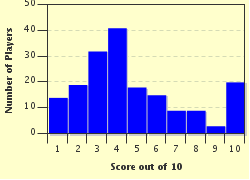Quiz Answer Key and Fun Facts
1. What was the SMLE's nickname?
2. What was the effective range of the SMLE?
3. One common problem with the Sten was that it commonly jammed. What was the other?
4. Sten's were easy weapons to make. What type of companies assisted in the production of Sten's?
5. One reason why the Bren was taken out of service after the war was because it was box fed, restricting it to 30 rounds before reloading. What was the other?
6. How many rounds per minute (RPM) could the Bren Gun achieve?
7. Due to its design, what other role could the PIAT have been used in?
8. What part of the design in the PIAT caused common shoulder injuries to users?
9. What was the heaviest part of the Vickers Medium Machine Gun?
10. Because the Vickers was water-cooled, the troops during the First World War used to take out the water once boiled and make tea out of it. Why wasn't this done during the Second World War?
Source: Author
Yin717
This quiz was reviewed by FunTrivia editor
bloomsby before going online.
Any errors found in FunTrivia content are routinely corrected through our feedback system.


